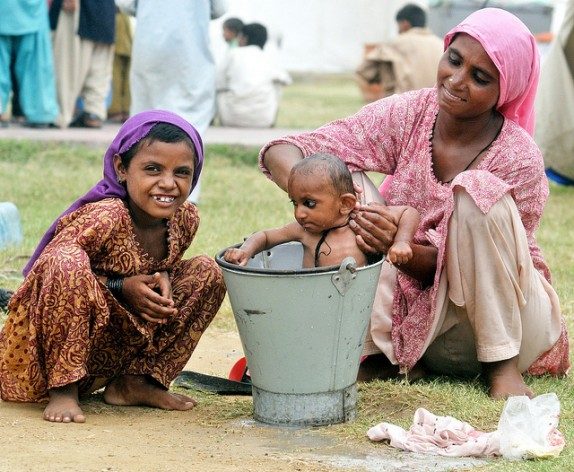A World of 8 Billion, Yes, but only a Few Are Seen as Human Beings (Part 1)
HUMAN RIGHTS, 11 Jul 2022
Baher Kamal | Human Wrongs Watch - TRANSCEND Media Service
7 Jul 2022 – Far-right Brazilian president, Jair Messias Bolsonaro, was quoted a year ago or so as saying to a small group of indigenous people that they “now look a bit more like humans.”

Since the middle of the 20th century, the world has experienced unprecedented population growth. The world’s population more than tripled in size between 1950 and 2020. Credit: Fahim Siddiqi/IPS
Tragically, a vast majority of this year’s record world population of 8 million is harshly neglected and seen as just disturbing numbers, if ever treated as such humans.
The world’s population has been growing too fast and, with it, the wave of staggering inequalities, human rights abuses and shockingly growing violence.
The facts about such a high speed population growth speak for themselves: for instance, it took hundreds of thousands of years for the world population to grow to 1 billion – then in just another 200 years or so, it grew seven-fold.
According to 2022 World Population Day (July 11), in 2011, the global population reached the 7 billion mark, it stood at almost 7.9 billion in 2021, and it’s expected to grow to around 8.5 billion in 2030, 9.7 billion in 2050, and 10.9 billion in 2100.
In short: the world’s population more than tripled in size in barely half a century, between 1950 and 2020.
This dramatic growth has been driven largely by increasing numbers of people surviving to reproductive age, and has been accompanied by major changes in fertility rates, increasing urbanisation and accelerating migration, explains the UN Population Fund (UNFPA).
These trends will have far-reaching implications for generations to come.
A good number of demographers may marvel at the advancements in health that have extended lifespans, reduced maternal mortality and child mortality and given rise to vaccine development in record time.
Others will tout technological innovations that have eased our lives and connected us more than ever. Still others will herald gains in gender equality, says the UN.
Inequality, discrimination, harassment, violence…
“But progress is not universal, throwing inequality into razor-sharp relief.”
The same concerns and challenges raised 11 years ago remain or have worsened: climate change, violence, discrimination, warns the World Population Day.
“The world reached a particularly grim milestone in May: More than 100 million forcibly displaced worldwide.”
In an ideal world, 8 billion people means 8 billion opportunities for healthier societies empowered by rights and choices.
But the playing field is not and has never been even. Based on gender, ethnicity, class, religion, sexual orientation, disability and origin, among other factors, too many are still exposed to discrimination, harassment and violence, warns the United Nations.
The wider picture
In fact, world’s politicians and media, in particular those of the heavily industrialised countries, have long been ignoring the other side of the coin. See for example:
- The richest 1% pollutes more than the poorest 50%. In fact, the Group of 20 major economies (G20) accounts for 78% of global greenhouse gas emissions. In contrast, in the specific case of Africa –54 countries home to 1.4 billion humans– causes a negligible 2% to 3% of all global greenhouse emissions, however it falls victim to more than 80% of the world’s climate catastrophes;
- Five more planets earth urgently needed if the current depletion of natural resources continues as expected;
- The risk of turning Planet Earth into a giant desert
- At the same time, alongside the causes of climate emergency, such a voracious profit-making business has been also leading to a fast growing land degradation and desertification.
Who is behind the destruction of biodiversity? Obviously, those who have been making voracious profits by exploiting the essential infrastructure of all kinds of life on Earth, through their industrial intensive agriculture, the collection of genetic resources of flora and fauna to register them as their own “property”, the production of genetically modified food, and the over-use of chemicals.
They are also the big timber business destroying forests, inducing the waste of huge amounts of agriculture and livestock products to keep their prices the most profitable possible, and a long, very long etcetera.
Meanwhile, Big business depletes Nature and supplants it with synthetic food. In fact, the fast increasing impact of such depletion, alongside conflicts and climate crises, have pushed millions of humans to flee their homes and migrate.
But in addition to dying in their migration journeys, they also fall easy prey to human trafficking and smuggling. See for example: Slave Markets Open 24/7: Refugee Babies, Boys, Girls, Women, Men…
Simultaneously, nuclear-armed powers continue to squander $156.000 per minute on their MAD Policy
One consequence is that right now there are new world records: more weapons than ever. And a hunger crisis like no other
Fertility rates, life expectancy, urbanisation…
Now back to the issue of population growth. The recent past has seen enormous changes in fertility rates and life expectancy. In the early 1970s, women had on average 4.5 children each; by 2015, total fertility for the world had fallen to below 2.5 children per woman.
Meanwhile, average global life spans have risen, from 64.6 years in the early 1990s to 72.6 years in 2019, according to this year’s World Population Day.
In addition, the world is seeing high levels of urbanisation and accelerating migration. 2007 was the first year in which more people lived in urban areas than in rural areas, and by 2050 about 66% of the world population will be living in cities.”
These megatrends have far-reaching implications. They affect economic development, employment, income distribution, poverty and social protections. They also affect efforts to ensure universal access to health care, education, housing, sanitation, water, food and energy.
More facts and figures
On the occasion of World Population Day, the UN Department of Economic and Social Affairs (DESA) reported the following:
- Since the middle of the 20th century, the world has experienced unprecedented population growth. The world’s population more than tripled in size between 1950 and 2020.
- The growth rate of the world’s population reached a peak between 1965 and 1970, when human numbers were increasing by an average of 2.1% per year.
- During the period from 2000 to 2020, even though the global population grew at an average annual rate of 1.2%, 48 countries or areas grew at least twice as fast: these included 33 countries or areas in Africa and 12 in Asia.
- The life span of adults in the developed world has increased since the middle of the 20th century – the number of people reaching the age of 100 years has never been greater than it is today.
Now that you have the two sides of today’s world before your eyes, please always consider the “human” face of the numbers.
_____________________________________________
READ: PART 2
 Baher Kamal, a member of the TRANSCEND Network for Peace Development Environment, is an Egyptian-born, Spanish national, secular journalist, with over 45 years of professional experience — from reporter to special envoy to chief editor of national dailies and an international news agency. Baher is former Senior Advisor to the Director General of the international news agency IPS (Inter Press Service) and he also contributed to prestigious magazines such as TRANSCEND Media Service, GEO, Muy Interesante, and Natura, Spain. He is also publisher and editor of Human Wrongs Watch.
Baher Kamal, a member of the TRANSCEND Network for Peace Development Environment, is an Egyptian-born, Spanish national, secular journalist, with over 45 years of professional experience — from reporter to special envoy to chief editor of national dailies and an international news agency. Baher is former Senior Advisor to the Director General of the international news agency IPS (Inter Press Service) and he also contributed to prestigious magazines such as TRANSCEND Media Service, GEO, Muy Interesante, and Natura, Spain. He is also publisher and editor of Human Wrongs Watch.
Go to Original – human-wrongs-watch.net
Tags: Elites, Humanism, Humanitarianism, Humanity, Indigenous Culture, Indigenous Rights, Inequality, Poverty, Super rich
DISCLAIMER: The statements, views and opinions expressed in pieces republished here are solely those of the authors and do not necessarily represent those of TMS. In accordance with title 17 U.S.C. section 107, this material is distributed without profit to those who have expressed a prior interest in receiving the included information for research and educational purposes. TMS has no affiliation whatsoever with the originator of this article nor is TMS endorsed or sponsored by the originator. “GO TO ORIGINAL” links are provided as a convenience to our readers and allow for verification of authenticity. However, as originating pages are often updated by their originating host sites, the versions posted may not match the versions our readers view when clicking the “GO TO ORIGINAL” links. This site contains copyrighted material the use of which has not always been specifically authorized by the copyright owner. We are making such material available in our efforts to advance understanding of environmental, political, human rights, economic, democracy, scientific, and social justice issues, etc. We believe this constitutes a ‘fair use’ of any such copyrighted material as provided for in section 107 of the US Copyright Law. In accordance with Title 17 U.S.C. Section 107, the material on this site is distributed without profit to those who have expressed a prior interest in receiving the included information for research and educational purposes. For more information go to: http://www.law.cornell.edu/uscode/17/107.shtml. If you wish to use copyrighted material from this site for purposes of your own that go beyond ‘fair use’, you must obtain permission from the copyright owner.